Role of Inclusion in Early Childhood Educational Settings Report
VerifiedAdded on 2020/12/18
|10
|3277
|179
Report
AI Summary
This report delves into the crucial role of supporting inclusion in early childhood educational settings. It begins by outlining the importance of inclusive practices for all children, particularly those with special needs, emphasizing the benefits of fostering a supportive learning environment. The report then critiques the strength-based approach, examining its advantages and disadvantages in promoting inclusion, such as focusing on a child's self-determination and strengths. It further discusses the significance of using an effective team approach to support inclusion, highlighting the collaborative efforts required to ensure all children have access to and actively participate in educational programs. The report also describes inclusive educational provisions for young children, detailing the factors and settings that contribute to a welcoming and supportive environment. The report emphasizes the importance of creating a sense of belonging and providing natural settings, such as home-like facilities and access to various educational resources, to promote the personal and cultural development of young children.
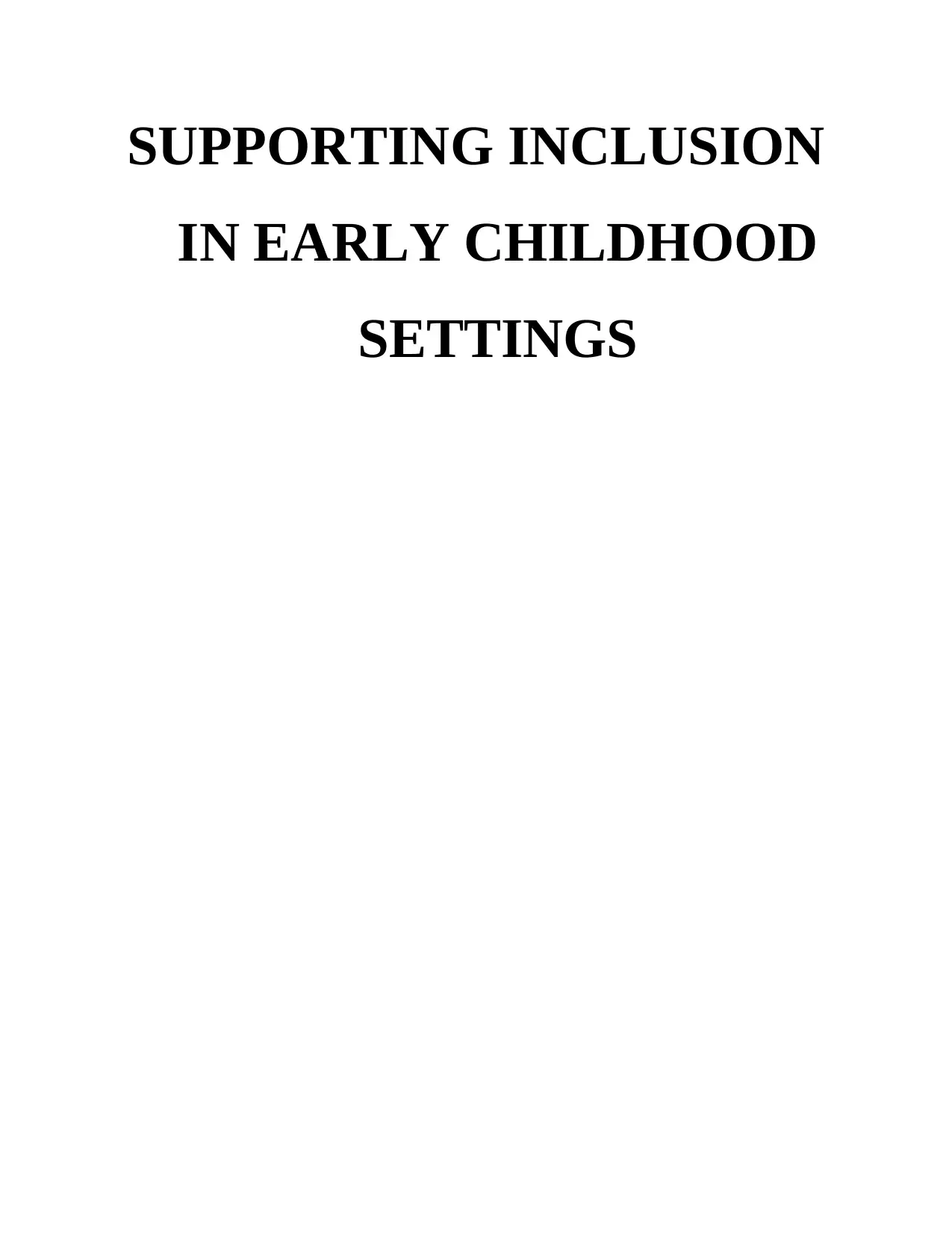
SUPPORTING INCLUSION
IN EARLY CHILDHOOD
SETTINGS
IN EARLY CHILDHOOD
SETTINGS
Paraphrase This Document
Need a fresh take? Get an instant paraphrase of this document with our AI Paraphraser
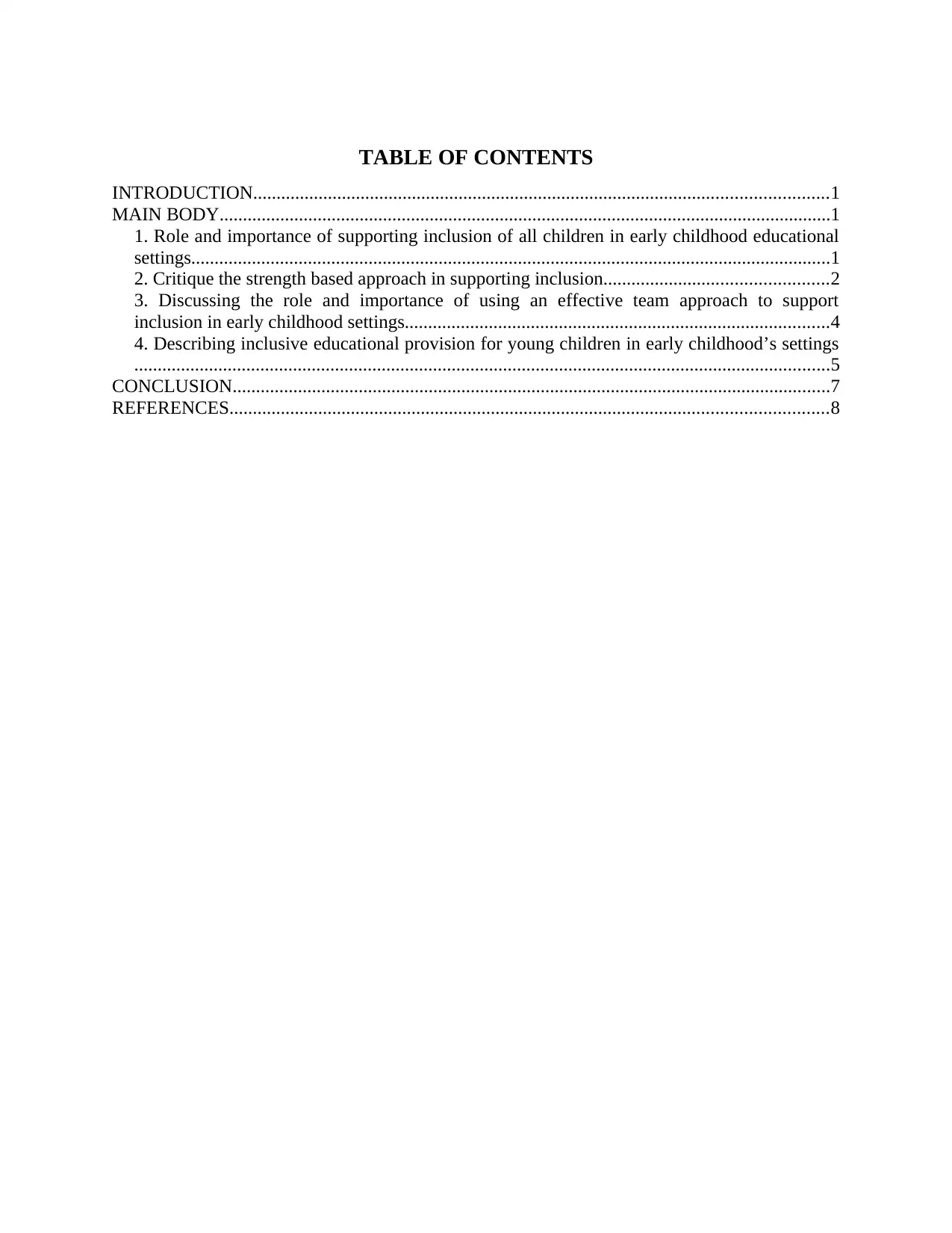
TABLE OF CONTENTS
INTRODUCTION...........................................................................................................................1
MAIN BODY...................................................................................................................................1
1. Role and importance of supporting inclusion of all children in early childhood educational
settings.........................................................................................................................................1
2. Critique the strength based approach in supporting inclusion................................................2
3. Discussing the role and importance of using an effective team approach to support
inclusion in early childhood settings...........................................................................................4
4. Describing inclusive educational provision for young children in early childhood’s settings
.....................................................................................................................................................5
CONCLUSION................................................................................................................................7
REFERENCES................................................................................................................................8
INTRODUCTION...........................................................................................................................1
MAIN BODY...................................................................................................................................1
1. Role and importance of supporting inclusion of all children in early childhood educational
settings.........................................................................................................................................1
2. Critique the strength based approach in supporting inclusion................................................2
3. Discussing the role and importance of using an effective team approach to support
inclusion in early childhood settings...........................................................................................4
4. Describing inclusive educational provision for young children in early childhood’s settings
.....................................................................................................................................................5
CONCLUSION................................................................................................................................7
REFERENCES................................................................................................................................8
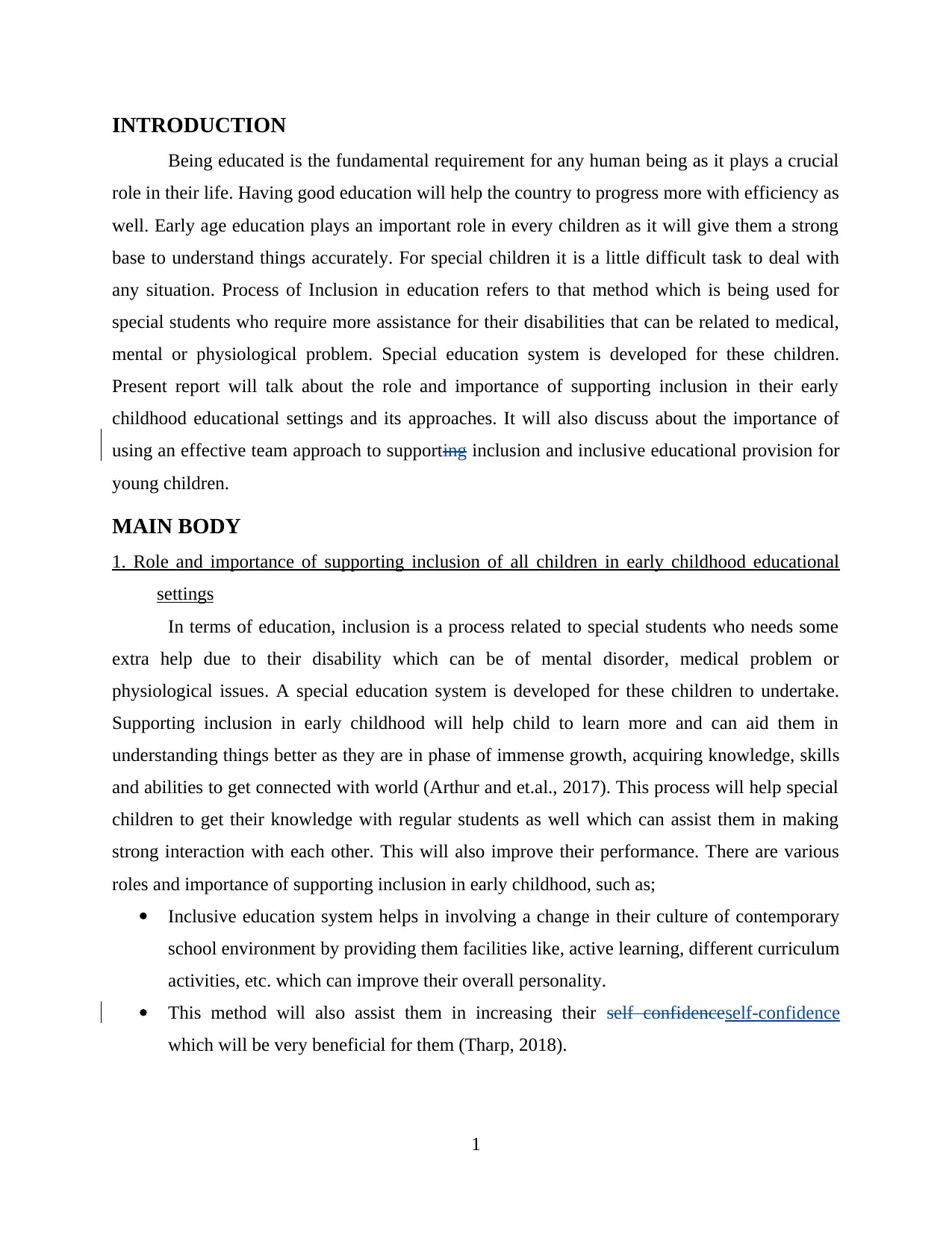
INTRODUCTION
Being educated is the fundamental requirement for any human being as it plays a crucial
role in their life. Having good education will help the country to progress more with efficiency as
well. Early age education plays an important role in every children as it will give them a strong
base to understand things accurately. For special children it is a little difficult task to deal with
any situation. Process of Inclusion in education refers to that method which is being used for
special students who require more assistance for their disabilities that can be related to medical,
mental or physiological problem. Special education system is developed for these children.
Present report will talk about the role and importance of supporting inclusion in their early
childhood educational settings and its approaches. It will also discuss about the importance of
using an effective team approach to supporting inclusion and inclusive educational provision for
young children.
MAIN BODY
1. Role and importance of supporting inclusion of all children in early childhood educational
settings
In terms of education, inclusion is a process related to special students who needs some
extra help due to their disability which can be of mental disorder, medical problem or
physiological issues. A special education system is developed for these children to undertake.
Supporting inclusion in early childhood will help child to learn more and can aid them in
understanding things better as they are in phase of immense growth, acquiring knowledge, skills
and abilities to get connected with world (Arthur and et.al., 2017). This process will help special
children to get their knowledge with regular students as well which can assist them in making
strong interaction with each other. This will also improve their performance. There are various
roles and importance of supporting inclusion in early childhood, such as;
Inclusive education system helps in involving a change in their culture of contemporary
school environment by providing them facilities like, active learning, different curriculum
activities, etc. which can improve their overall personality.
This method will also assist them in increasing their self confidenceself-confidence
which will be very beneficial for them (Tharp, 2018).
1
Being educated is the fundamental requirement for any human being as it plays a crucial
role in their life. Having good education will help the country to progress more with efficiency as
well. Early age education plays an important role in every children as it will give them a strong
base to understand things accurately. For special children it is a little difficult task to deal with
any situation. Process of Inclusion in education refers to that method which is being used for
special students who require more assistance for their disabilities that can be related to medical,
mental or physiological problem. Special education system is developed for these children.
Present report will talk about the role and importance of supporting inclusion in their early
childhood educational settings and its approaches. It will also discuss about the importance of
using an effective team approach to supporting inclusion and inclusive educational provision for
young children.
MAIN BODY
1. Role and importance of supporting inclusion of all children in early childhood educational
settings
In terms of education, inclusion is a process related to special students who needs some
extra help due to their disability which can be of mental disorder, medical problem or
physiological issues. A special education system is developed for these children to undertake.
Supporting inclusion in early childhood will help child to learn more and can aid them in
understanding things better as they are in phase of immense growth, acquiring knowledge, skills
and abilities to get connected with world (Arthur and et.al., 2017). This process will help special
children to get their knowledge with regular students as well which can assist them in making
strong interaction with each other. This will also improve their performance. There are various
roles and importance of supporting inclusion in early childhood, such as;
Inclusive education system helps in involving a change in their culture of contemporary
school environment by providing them facilities like, active learning, different curriculum
activities, etc. which can improve their overall personality.
This method will also assist them in increasing their self confidenceself-confidence
which will be very beneficial for them (Tharp, 2018).
1
⊘ This is a preview!⊘
Do you want full access?
Subscribe today to unlock all pages.

Trusted by 1+ million students worldwide
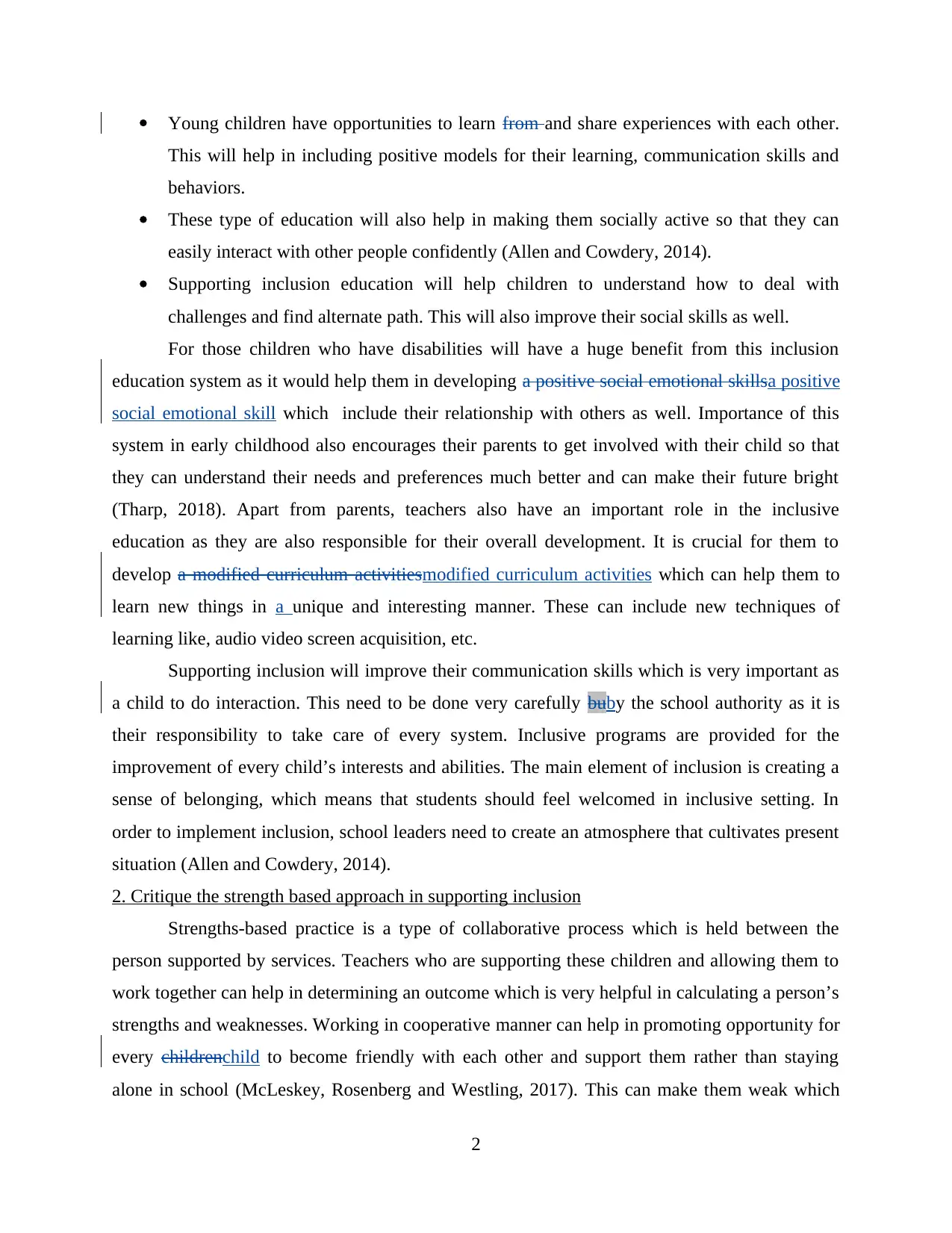
Young children have opportunities to learn from and share experiences with each other.
This will help in including positive models for their learning, communication skills and
behaviors.
These type of education will also help in making them socially active so that they can
easily interact with other people confidently (Allen and Cowdery, 2014).
Supporting inclusion education will help children to understand how to deal with
challenges and find alternate path. This will also improve their social skills as well.
For those children who have disabilities will have a huge benefit from this inclusion
education system as it would help them in developing a positive social emotional skillsa positive
social emotional skill which include their relationship with others as well. Importance of this
system in early childhood also encourages their parents to get involved with their child so that
they can understand their needs and preferences much better and can make their future bright
(Tharp, 2018). Apart from parents, teachers also have an important role in the inclusive
education as they are also responsible for their overall development. It is crucial for them to
develop a modified curriculum activitiesmodified curriculum activities which can help them to
learn new things in a unique and interesting manner. These can include new techniques of
learning like, audio video screen acquisition, etc.
Supporting inclusion will improve their communication skills which is very important as
a child to do interaction. This need to be done very carefully buby the school authority as it is
their responsibility to take care of every system. Inclusive programs are provided for the
improvement of every child’s interests and abilities. The main element of inclusion is creating a
sense of belonging, which means that students should feel welcomed in inclusive setting. In
order to implement inclusion, school leaders need to create an atmosphere that cultivates present
situation (Allen and Cowdery, 2014).
2. Critique the strength based approach in supporting inclusion
Strengths-based practice is a type of collaborative process which is held between the
person supported by services. Teachers who are supporting these children and allowing them to
work together can help in determining an outcome which is very helpful in calculating a person’s
strengths and weaknesses. Working in cooperative manner can help in promoting opportunity for
every childrenchild to become friendly with each other and support them rather than staying
alone in school (McLeskey, Rosenberg and Westling, 2017). This can make them weak which
2
This will help in including positive models for their learning, communication skills and
behaviors.
These type of education will also help in making them socially active so that they can
easily interact with other people confidently (Allen and Cowdery, 2014).
Supporting inclusion education will help children to understand how to deal with
challenges and find alternate path. This will also improve their social skills as well.
For those children who have disabilities will have a huge benefit from this inclusion
education system as it would help them in developing a positive social emotional skillsa positive
social emotional skill which include their relationship with others as well. Importance of this
system in early childhood also encourages their parents to get involved with their child so that
they can understand their needs and preferences much better and can make their future bright
(Tharp, 2018). Apart from parents, teachers also have an important role in the inclusive
education as they are also responsible for their overall development. It is crucial for them to
develop a modified curriculum activitiesmodified curriculum activities which can help them to
learn new things in a unique and interesting manner. These can include new techniques of
learning like, audio video screen acquisition, etc.
Supporting inclusion will improve their communication skills which is very important as
a child to do interaction. This need to be done very carefully buby the school authority as it is
their responsibility to take care of every system. Inclusive programs are provided for the
improvement of every child’s interests and abilities. The main element of inclusion is creating a
sense of belonging, which means that students should feel welcomed in inclusive setting. In
order to implement inclusion, school leaders need to create an atmosphere that cultivates present
situation (Allen and Cowdery, 2014).
2. Critique the strength based approach in supporting inclusion
Strengths-based practice is a type of collaborative process which is held between the
person supported by services. Teachers who are supporting these children and allowing them to
work together can help in determining an outcome which is very helpful in calculating a person’s
strengths and weaknesses. Working in cooperative manner can help in promoting opportunity for
every childrenchild to become friendly with each other and support them rather than staying
alone in school (McLeskey, Rosenberg and Westling, 2017). This can make them weak which
2
Paraphrase This Document
Need a fresh take? Get an instant paraphrase of this document with our AI Paraphraser
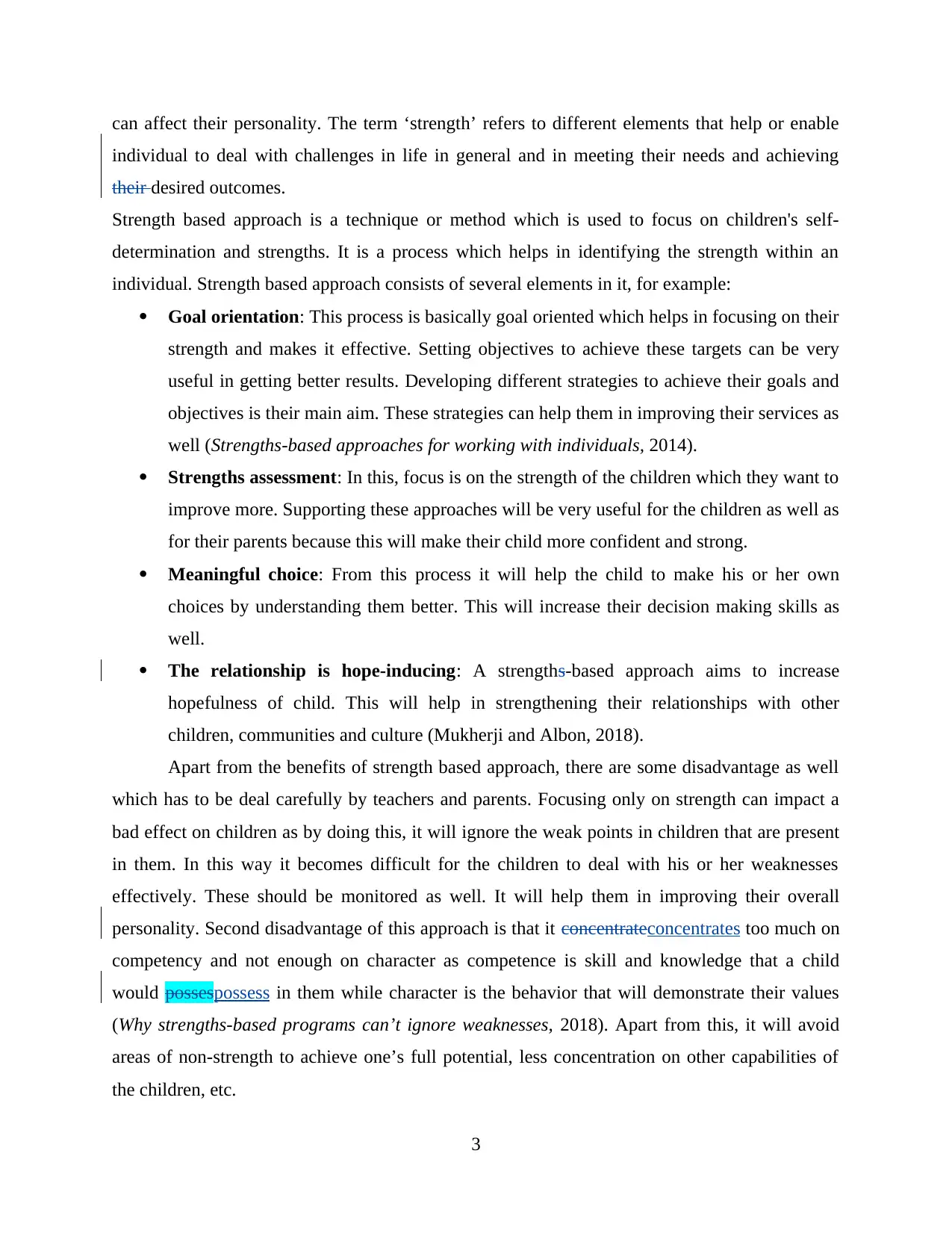
can affect their personality. The term ‘strength’ refers to different elements that help or enable
individual to deal with challenges in life in general and in meeting their needs and achieving
their desired outcomes.
Strength based approach is a technique or method which is used to focus on children's self-
determination and strengths. It is a process which helps in identifying the strength within an
individual. Strength based approach consists of several elements in it, for example:
Goal orientation: This process is basically goal oriented which helps in focusing on their
strength and makes it effective. Setting objectives to achieve these targets can be very
useful in getting better results. Developing different strategies to achieve their goals and
objectives is their main aim. These strategies can help them in improving their services as
well (Strengths-based approaches for working with individuals, 2014).
Strengths assessment: In this, focus is on the strength of the children which they want to
improve more. Supporting these approaches will be very useful for the children as well as
for their parents because this will make their child more confident and strong.
Meaningful choice: From this process it will help the child to make his or her own
choices by understanding them better. This will increase their decision making skills as
well.
The relationship is hope-inducing: A strengths-based approach aims to increase
hopefulness of child. This will help in strengthening their relationships with other
children, communities and culture (Mukherji and Albon, 2018).
Apart from the benefits of strength based approach, there are some disadvantage as well
which has to be deal carefully by teachers and parents. Focusing only on strength can impact a
bad effect on children as by doing this, it will ignore the weak points in children that are present
in them. In this way it becomes difficult for the children to deal with his or her weaknesses
effectively. These should be monitored as well. It will help them in improving their overall
personality. Second disadvantage of this approach is that it concentrateconcentrates too much on
competency and not enough on character as competence is skill and knowledge that a child
would possespossess in them while character is the behavior that will demonstrate their values
(Why strengths-based programs can’t ignore weaknesses, 2018). Apart from this, it will avoid
areas of non-strength to achieve one’s full potential, less concentration on other capabilities of
the children, etc.
3
individual to deal with challenges in life in general and in meeting their needs and achieving
their desired outcomes.
Strength based approach is a technique or method which is used to focus on children's self-
determination and strengths. It is a process which helps in identifying the strength within an
individual. Strength based approach consists of several elements in it, for example:
Goal orientation: This process is basically goal oriented which helps in focusing on their
strength and makes it effective. Setting objectives to achieve these targets can be very
useful in getting better results. Developing different strategies to achieve their goals and
objectives is their main aim. These strategies can help them in improving their services as
well (Strengths-based approaches for working with individuals, 2014).
Strengths assessment: In this, focus is on the strength of the children which they want to
improve more. Supporting these approaches will be very useful for the children as well as
for their parents because this will make their child more confident and strong.
Meaningful choice: From this process it will help the child to make his or her own
choices by understanding them better. This will increase their decision making skills as
well.
The relationship is hope-inducing: A strengths-based approach aims to increase
hopefulness of child. This will help in strengthening their relationships with other
children, communities and culture (Mukherji and Albon, 2018).
Apart from the benefits of strength based approach, there are some disadvantage as well
which has to be deal carefully by teachers and parents. Focusing only on strength can impact a
bad effect on children as by doing this, it will ignore the weak points in children that are present
in them. In this way it becomes difficult for the children to deal with his or her weaknesses
effectively. These should be monitored as well. It will help them in improving their overall
personality. Second disadvantage of this approach is that it concentrateconcentrates too much on
competency and not enough on character as competence is skill and knowledge that a child
would possespossess in them while character is the behavior that will demonstrate their values
(Why strengths-based programs can’t ignore weaknesses, 2018). Apart from this, it will avoid
areas of non-strength to achieve one’s full potential, less concentration on other capabilities of
the children, etc.
3
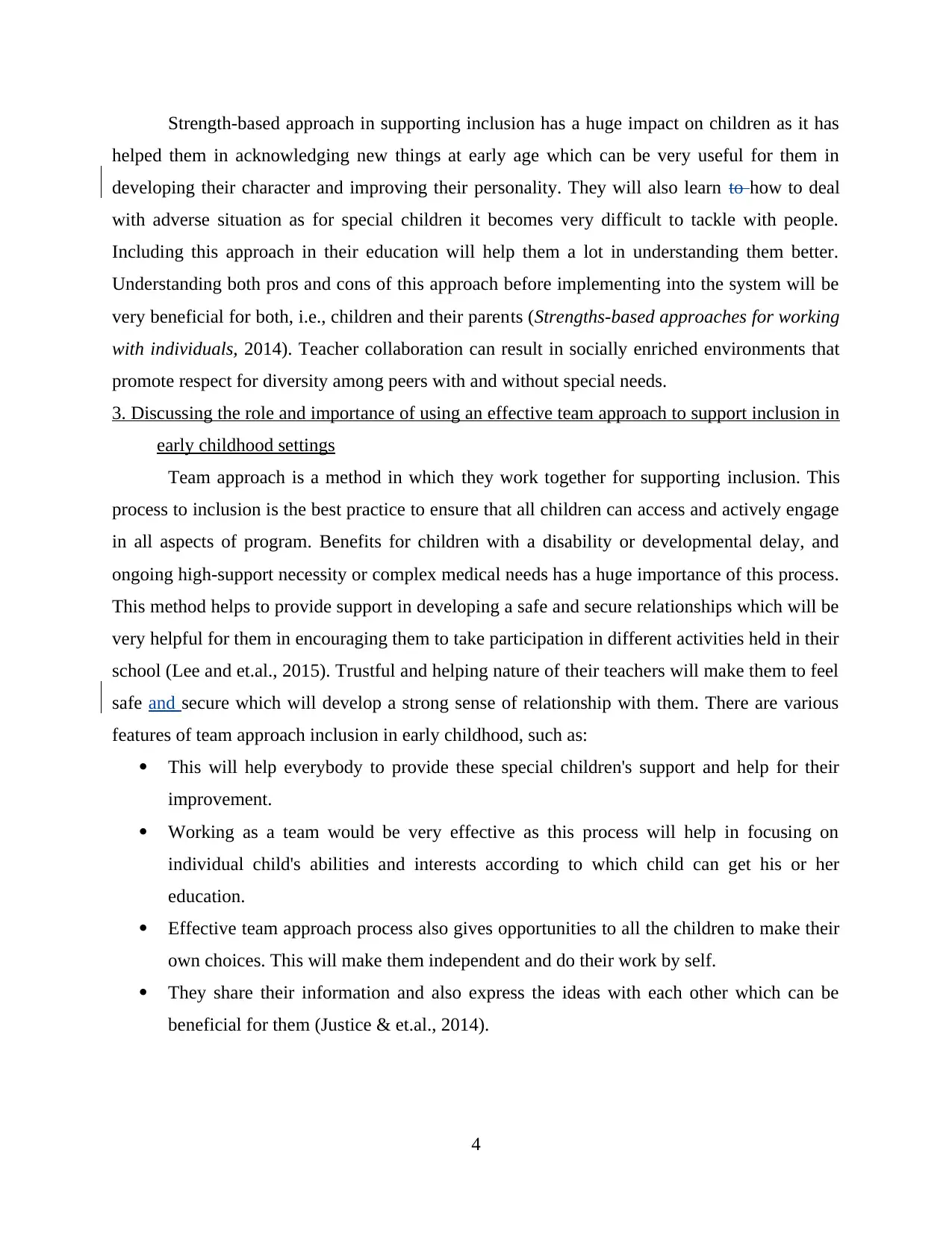
Strength-based approach in supporting inclusion has a huge impact on children as it has
helped them in acknowledging new things at early age which can be very useful for them in
developing their character and improving their personality. They will also learn to how to deal
with adverse situation as for special children it becomes very difficult to tackle with people.
Including this approach in their education will help them a lot in understanding them better.
Understanding both pros and cons of this approach before implementing into the system will be
very beneficial for both, i.e., children and their parents (Strengths-based approaches for working
with individuals, 2014). Teacher collaboration can result in socially enriched environments that
promote respect for diversity among peers with and without special needs.
3. Discussing the role and importance of using an effective team approach to support inclusion in
early childhood settings
Team approach is a method in which they work together for supporting inclusion. This
process to inclusion is the best practice to ensure that all children can access and actively engage
in all aspects of program. Benefits for children with a disability or developmental delay, and
ongoing high-support necessity or complex medical needs has a huge importance of this process.
This method helps to provide support in developing a safe and secure relationships which will be
very helpful for them in encouraging them to take participation in different activities held in their
school (Lee and et.al., 2015). Trustful and helping nature of their teachers will make them to feel
safe and secure which will develop a strong sense of relationship with them. There are various
features of team approach inclusion in early childhood, such as:
This will help everybody to provide these special children's support and help for their
improvement.
Working as a team would be very effective as this process will help in focusing on
individual child's abilities and interests according to which child can get his or her
education.
Effective team approach process also gives opportunities to all the children to make their
own choices. This will make them independent and do their work by self.
They share their information and also express the ideas with each other which can be
beneficial for them (Justice & et.al., 2014).
4
helped them in acknowledging new things at early age which can be very useful for them in
developing their character and improving their personality. They will also learn to how to deal
with adverse situation as for special children it becomes very difficult to tackle with people.
Including this approach in their education will help them a lot in understanding them better.
Understanding both pros and cons of this approach before implementing into the system will be
very beneficial for both, i.e., children and their parents (Strengths-based approaches for working
with individuals, 2014). Teacher collaboration can result in socially enriched environments that
promote respect for diversity among peers with and without special needs.
3. Discussing the role and importance of using an effective team approach to support inclusion in
early childhood settings
Team approach is a method in which they work together for supporting inclusion. This
process to inclusion is the best practice to ensure that all children can access and actively engage
in all aspects of program. Benefits for children with a disability or developmental delay, and
ongoing high-support necessity or complex medical needs has a huge importance of this process.
This method helps to provide support in developing a safe and secure relationships which will be
very helpful for them in encouraging them to take participation in different activities held in their
school (Lee and et.al., 2015). Trustful and helping nature of their teachers will make them to feel
safe and secure which will develop a strong sense of relationship with them. There are various
features of team approach inclusion in early childhood, such as:
This will help everybody to provide these special children's support and help for their
improvement.
Working as a team would be very effective as this process will help in focusing on
individual child's abilities and interests according to which child can get his or her
education.
Effective team approach process also gives opportunities to all the children to make their
own choices. This will make them independent and do their work by self.
They share their information and also express the ideas with each other which can be
beneficial for them (Justice & et.al., 2014).
4
⊘ This is a preview!⊘
Do you want full access?
Subscribe today to unlock all pages.

Trusted by 1+ million students worldwide
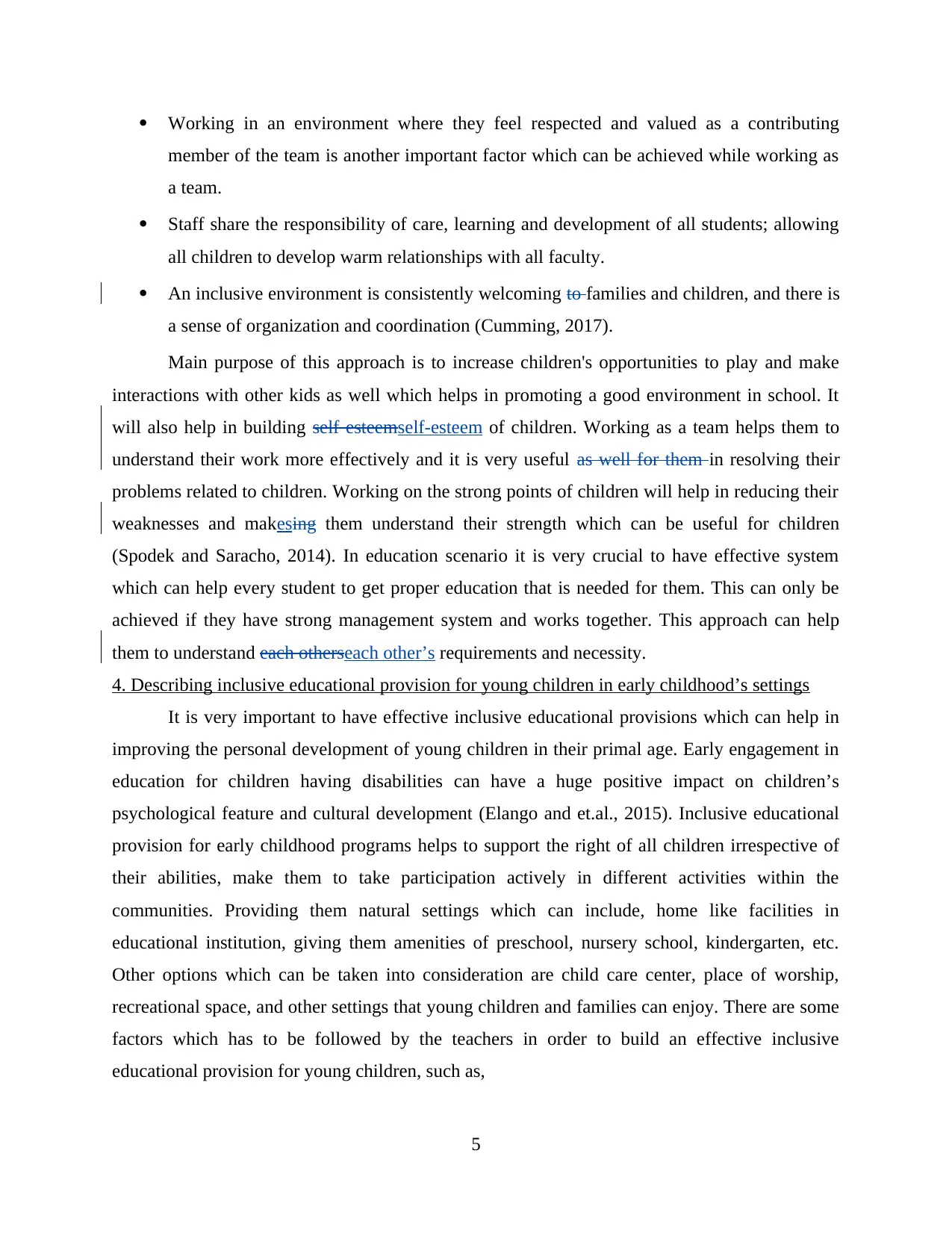
Working in an environment where they feel respected and valued as a contributing
member of the team is another important factor which can be achieved while working as
a team.
Staff share the responsibility of care, learning and development of all students; allowing
all children to develop warm relationships with all faculty.
An inclusive environment is consistently welcoming to families and children, and there is
a sense of organization and coordination (Cumming, 2017).
Main purpose of this approach is to increase children's opportunities to play and make
interactions with other kids as well which helps in promoting a good environment in school. It
will also help in building self esteemself-esteem of children. Working as a team helps them to
understand their work more effectively and it is very useful as well for them in resolving their
problems related to children. Working on the strong points of children will help in reducing their
weaknesses and makesing them understand their strength which can be useful for children
(Spodek and Saracho, 2014). In education scenario it is very crucial to have effective system
which can help every student to get proper education that is needed for them. This can only be
achieved if they have strong management system and works together. This approach can help
them to understand each otherseach other’s requirements and necessity.
4. Describing inclusive educational provision for young children in early childhood’s settings
It is very important to have effective inclusive educational provisions which can help in
improving the personal development of young children in their primal age. Early engagement in
education for children having disabilities can have a huge positive impact on children’s
psychological feature and cultural development (Elango and et.al., 2015). Inclusive educational
provision for early childhood programs helps to support the right of all children irrespective of
their abilities, make them to take participation actively in different activities within the
communities. Providing them natural settings which can include, home like facilities in
educational institution, giving them amenities of preschool, nursery school, kindergarten, etc.
Other options which can be taken into consideration are child care center, place of worship,
recreational space, and other settings that young children and families can enjoy. There are some
factors which has to be followed by the teachers in order to build an effective inclusive
educational provision for young children, such as,
5
member of the team is another important factor which can be achieved while working as
a team.
Staff share the responsibility of care, learning and development of all students; allowing
all children to develop warm relationships with all faculty.
An inclusive environment is consistently welcoming to families and children, and there is
a sense of organization and coordination (Cumming, 2017).
Main purpose of this approach is to increase children's opportunities to play and make
interactions with other kids as well which helps in promoting a good environment in school. It
will also help in building self esteemself-esteem of children. Working as a team helps them to
understand their work more effectively and it is very useful as well for them in resolving their
problems related to children. Working on the strong points of children will help in reducing their
weaknesses and makesing them understand their strength which can be useful for children
(Spodek and Saracho, 2014). In education scenario it is very crucial to have effective system
which can help every student to get proper education that is needed for them. This can only be
achieved if they have strong management system and works together. This approach can help
them to understand each otherseach other’s requirements and necessity.
4. Describing inclusive educational provision for young children in early childhood’s settings
It is very important to have effective inclusive educational provisions which can help in
improving the personal development of young children in their primal age. Early engagement in
education for children having disabilities can have a huge positive impact on children’s
psychological feature and cultural development (Elango and et.al., 2015). Inclusive educational
provision for early childhood programs helps to support the right of all children irrespective of
their abilities, make them to take participation actively in different activities within the
communities. Providing them natural settings which can include, home like facilities in
educational institution, giving them amenities of preschool, nursery school, kindergarten, etc.
Other options which can be taken into consideration are child care center, place of worship,
recreational space, and other settings that young children and families can enjoy. There are some
factors which has to be followed by the teachers in order to build an effective inclusive
educational provision for young children, such as,
5
Paraphrase This Document
Need a fresh take? Get an instant paraphrase of this document with our AI Paraphraser
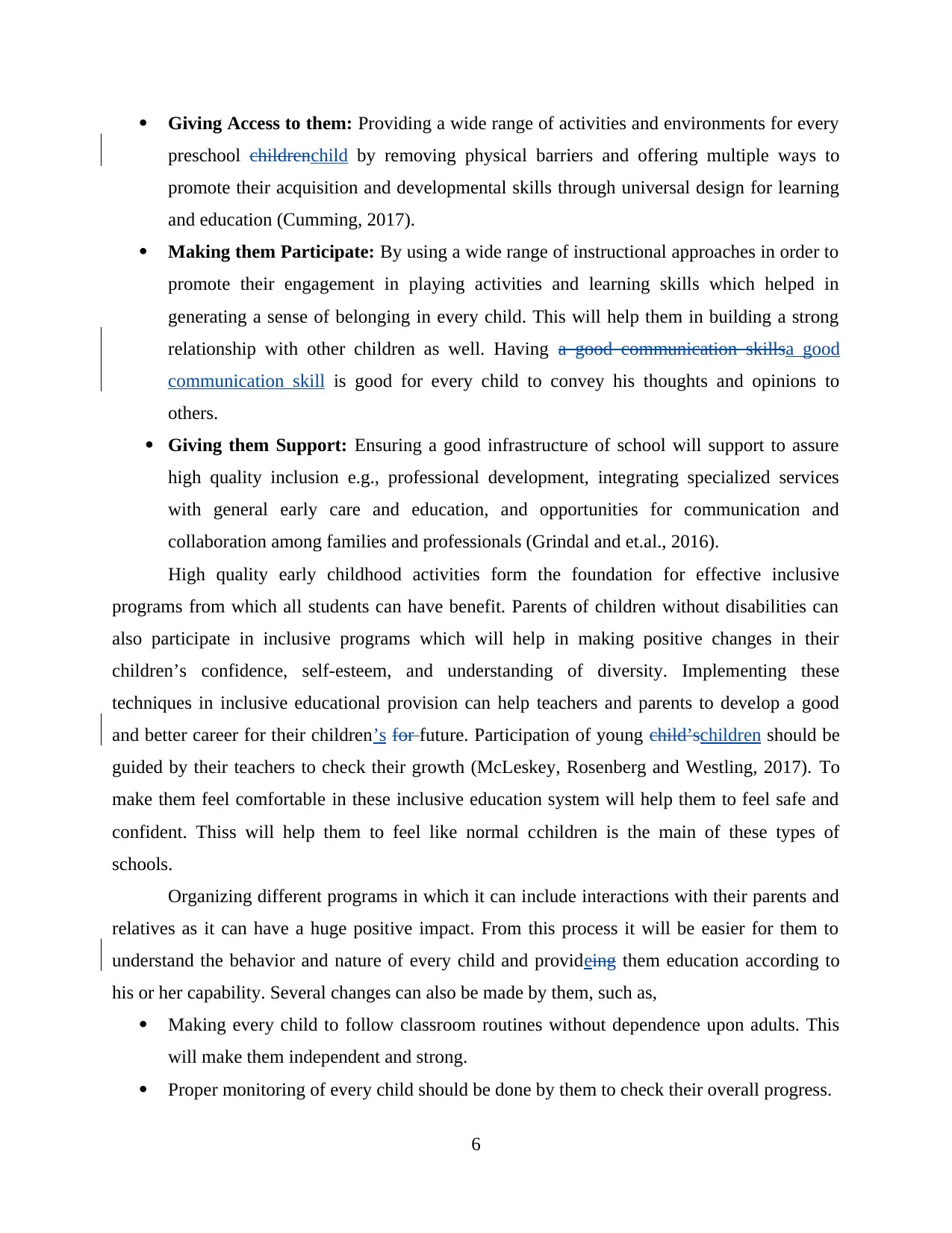
Giving Access to them: Providing a wide range of activities and environments for every
preschool childrenchild by removing physical barriers and offering multiple ways to
promote their acquisition and developmental skills through universal design for learning
and education (Cumming, 2017).
Making them Participate: By using a wide range of instructional approaches in order to
promote their engagement in playing activities and learning skills which helped in
generating a sense of belonging in every child. This will help them in building a strong
relationship with other children as well. Having a good communication skillsa good
communication skill is good for every child to convey his thoughts and opinions to
others.
Giving them Support: Ensuring a good infrastructure of school will support to assure
high quality inclusion e.g., professional development, integrating specialized services
with general early care and education, and opportunities for communication and
collaboration among families and professionals (Grindal and et.al., 2016).
High quality early childhood activities form the foundation for effective inclusive
programs from which all students can have benefit. Parents of children without disabilities can
also participate in inclusive programs which will help in making positive changes in their
children’s confidence, self-esteem, and understanding of diversity. Implementing these
techniques in inclusive educational provision can help teachers and parents to develop a good
and better career for their children’s for future. Participation of young child’schildren should be
guided by their teachers to check their growth (McLeskey, Rosenberg and Westling, 2017). To
make them feel comfortable in these inclusive education system will help them to feel safe and
confident. Thiss will help them to feel like normal cchildren is the main of these types of
schools.
Organizing different programs in which it can include interactions with their parents and
relatives as it can have a huge positive impact. From this process it will be easier for them to
understand the behavior and nature of every child and provideing them education according to
his or her capability. Several changes can also be made by them, such as,
Making every child to follow classroom routines without dependence upon adults. This
will make them independent and strong.
Proper monitoring of every child should be done by them to check their overall progress.
6
preschool childrenchild by removing physical barriers and offering multiple ways to
promote their acquisition and developmental skills through universal design for learning
and education (Cumming, 2017).
Making them Participate: By using a wide range of instructional approaches in order to
promote their engagement in playing activities and learning skills which helped in
generating a sense of belonging in every child. This will help them in building a strong
relationship with other children as well. Having a good communication skillsa good
communication skill is good for every child to convey his thoughts and opinions to
others.
Giving them Support: Ensuring a good infrastructure of school will support to assure
high quality inclusion e.g., professional development, integrating specialized services
with general early care and education, and opportunities for communication and
collaboration among families and professionals (Grindal and et.al., 2016).
High quality early childhood activities form the foundation for effective inclusive
programs from which all students can have benefit. Parents of children without disabilities can
also participate in inclusive programs which will help in making positive changes in their
children’s confidence, self-esteem, and understanding of diversity. Implementing these
techniques in inclusive educational provision can help teachers and parents to develop a good
and better career for their children’s for future. Participation of young child’schildren should be
guided by their teachers to check their growth (McLeskey, Rosenberg and Westling, 2017). To
make them feel comfortable in these inclusive education system will help them to feel safe and
confident. Thiss will help them to feel like normal cchildren is the main of these types of
schools.
Organizing different programs in which it can include interactions with their parents and
relatives as it can have a huge positive impact. From this process it will be easier for them to
understand the behavior and nature of every child and provideing them education according to
his or her capability. Several changes can also be made by them, such as,
Making every child to follow classroom routines without dependence upon adults. This
will make them independent and strong.
Proper monitoring of every child should be done by them to check their overall progress.
6
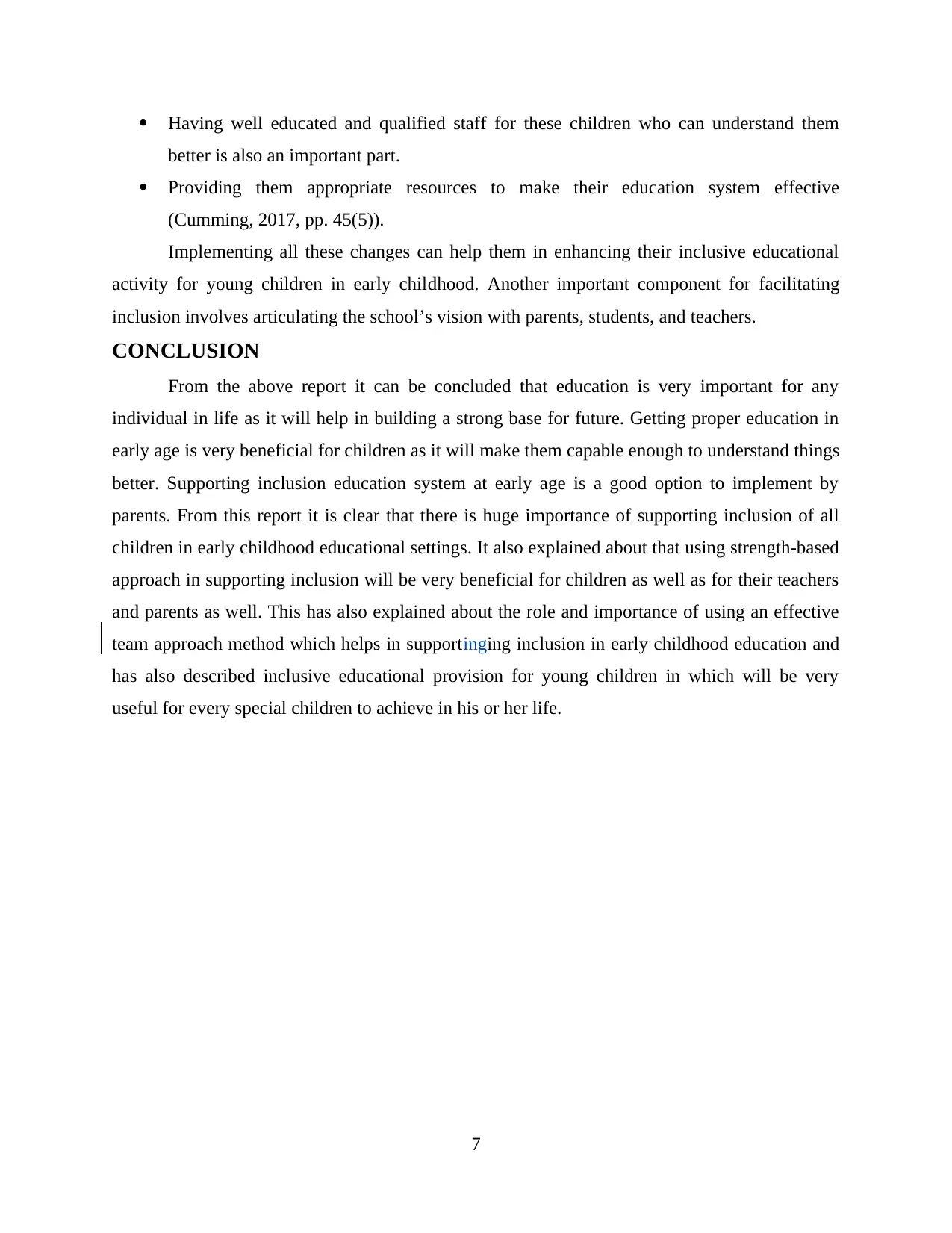
Having well educated and qualified staff for these children who can understand them
better is also an important part.
Providing them appropriate resources to make their education system effective
(Cumming, 2017, pp. 45(5)).
Implementing all these changes can help them in enhancing their inclusive educational
activity for young children in early childhood. Another important component for facilitating
inclusion involves articulating the school’s vision with parents, students, and teachers.
CONCLUSION
From the above report it can be concluded that education is very important for any
individual in life as it will help in building a strong base for future. Getting proper education in
early age is very beneficial for children as it will make them capable enough to understand things
better. Supporting inclusion education system at early age is a good option to implement by
parents. From this report it is clear that there is huge importance of supporting inclusion of all
children in early childhood educational settings. It also explained about that using strength-based
approach in supporting inclusion will be very beneficial for children as well as for their teachers
and parents as well. This has also explained about the role and importance of using an effective
team approach method which helps in supportinging inclusion in early childhood education and
has also described inclusive educational provision for young children in which will be very
useful for every special children to achieve in his or her life.
7
better is also an important part.
Providing them appropriate resources to make their education system effective
(Cumming, 2017, pp. 45(5)).
Implementing all these changes can help them in enhancing their inclusive educational
activity for young children in early childhood. Another important component for facilitating
inclusion involves articulating the school’s vision with parents, students, and teachers.
CONCLUSION
From the above report it can be concluded that education is very important for any
individual in life as it will help in building a strong base for future. Getting proper education in
early age is very beneficial for children as it will make them capable enough to understand things
better. Supporting inclusion education system at early age is a good option to implement by
parents. From this report it is clear that there is huge importance of supporting inclusion of all
children in early childhood educational settings. It also explained about that using strength-based
approach in supporting inclusion will be very beneficial for children as well as for their teachers
and parents as well. This has also explained about the role and importance of using an effective
team approach method which helps in supportinging inclusion in early childhood education and
has also described inclusive educational provision for young children in which will be very
useful for every special children to achieve in his or her life.
7
⊘ This is a preview!⊘
Do you want full access?
Subscribe today to unlock all pages.

Trusted by 1+ million students worldwide
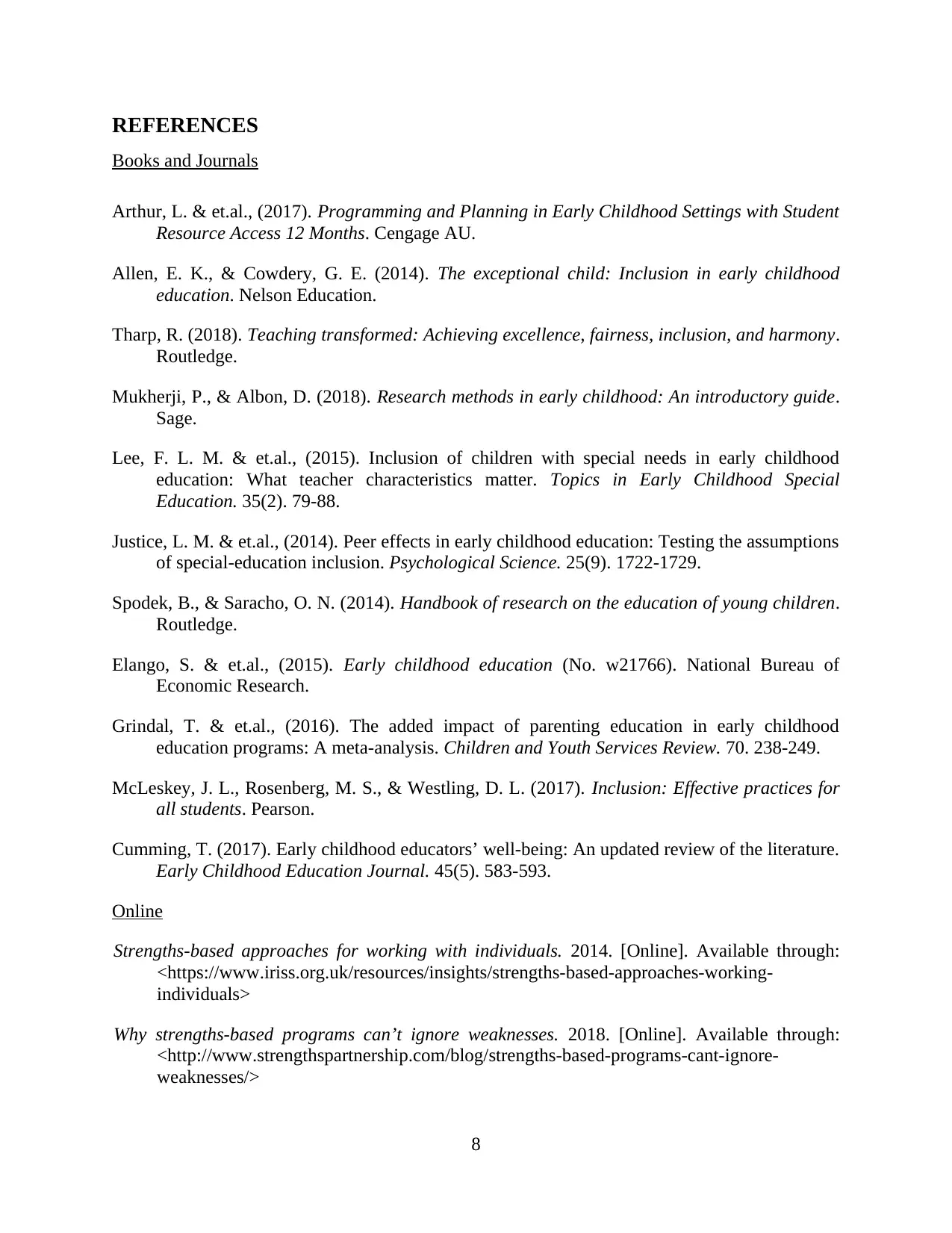
REFERENCES
Books and Journals
Arthur, L. & et.al., (2017). Programming and Planning in Early Childhood Settings with Student
Resource Access 12 Months. Cengage AU.
Allen, E. K., & Cowdery, G. E. (2014). The exceptional child: Inclusion in early childhood
education. Nelson Education.
Tharp, R. (2018). Teaching transformed: Achieving excellence, fairness, inclusion, and harmony.
Routledge.
Mukherji, P., & Albon, D. (2018). Research methods in early childhood: An introductory guide.
Sage.
Lee, F. L. M. & et.al., (2015). Inclusion of children with special needs in early childhood
education: What teacher characteristics matter. Topics in Early Childhood Special
Education. 35(2). 79-88.
Justice, L. M. & et.al., (2014). Peer effects in early childhood education: Testing the assumptions
of special-education inclusion. Psychological Science. 25(9). 1722-1729.
Spodek, B., & Saracho, O. N. (2014). Handbook of research on the education of young children.
Routledge.
Elango, S. & et.al., (2015). Early childhood education (No. w21766). National Bureau of
Economic Research.
Grindal, T. & et.al., (2016). The added impact of parenting education in early childhood
education programs: A meta-analysis. Children and Youth Services Review. 70. 238-249.
McLeskey, J. L., Rosenberg, M. S., & Westling, D. L. (2017). Inclusion: Effective practices for
all students. Pearson.
Cumming, T. (2017). Early childhood educators’ well-being: An updated review of the literature.
Early Childhood Education Journal. 45(5). 583-593.
Online
Strengths-based approaches for working with individuals. 2014. [Online]. Available through:
<https://www.iriss.org.uk/resources/insights/strengths-based-approaches-working-
individuals>
Why strengths-based programs can’t ignore weaknesses. 2018. [Online]. Available through:
<http://www.strengthspartnership.com/blog/strengths-based-programs-cant-ignore-
weaknesses/>
8
Books and Journals
Arthur, L. & et.al., (2017). Programming and Planning in Early Childhood Settings with Student
Resource Access 12 Months. Cengage AU.
Allen, E. K., & Cowdery, G. E. (2014). The exceptional child: Inclusion in early childhood
education. Nelson Education.
Tharp, R. (2018). Teaching transformed: Achieving excellence, fairness, inclusion, and harmony.
Routledge.
Mukherji, P., & Albon, D. (2018). Research methods in early childhood: An introductory guide.
Sage.
Lee, F. L. M. & et.al., (2015). Inclusion of children with special needs in early childhood
education: What teacher characteristics matter. Topics in Early Childhood Special
Education. 35(2). 79-88.
Justice, L. M. & et.al., (2014). Peer effects in early childhood education: Testing the assumptions
of special-education inclusion. Psychological Science. 25(9). 1722-1729.
Spodek, B., & Saracho, O. N. (2014). Handbook of research on the education of young children.
Routledge.
Elango, S. & et.al., (2015). Early childhood education (No. w21766). National Bureau of
Economic Research.
Grindal, T. & et.al., (2016). The added impact of parenting education in early childhood
education programs: A meta-analysis. Children and Youth Services Review. 70. 238-249.
McLeskey, J. L., Rosenberg, M. S., & Westling, D. L. (2017). Inclusion: Effective practices for
all students. Pearson.
Cumming, T. (2017). Early childhood educators’ well-being: An updated review of the literature.
Early Childhood Education Journal. 45(5). 583-593.
Online
Strengths-based approaches for working with individuals. 2014. [Online]. Available through:
<https://www.iriss.org.uk/resources/insights/strengths-based-approaches-working-
individuals>
Why strengths-based programs can’t ignore weaknesses. 2018. [Online]. Available through:
<http://www.strengthspartnership.com/blog/strengths-based-programs-cant-ignore-
weaknesses/>
8
1 out of 10
Related Documents
Your All-in-One AI-Powered Toolkit for Academic Success.
+13062052269
info@desklib.com
Available 24*7 on WhatsApp / Email
![[object Object]](/_next/static/media/star-bottom.7253800d.svg)
Unlock your academic potential
Copyright © 2020–2025 A2Z Services. All Rights Reserved. Developed and managed by ZUCOL.





